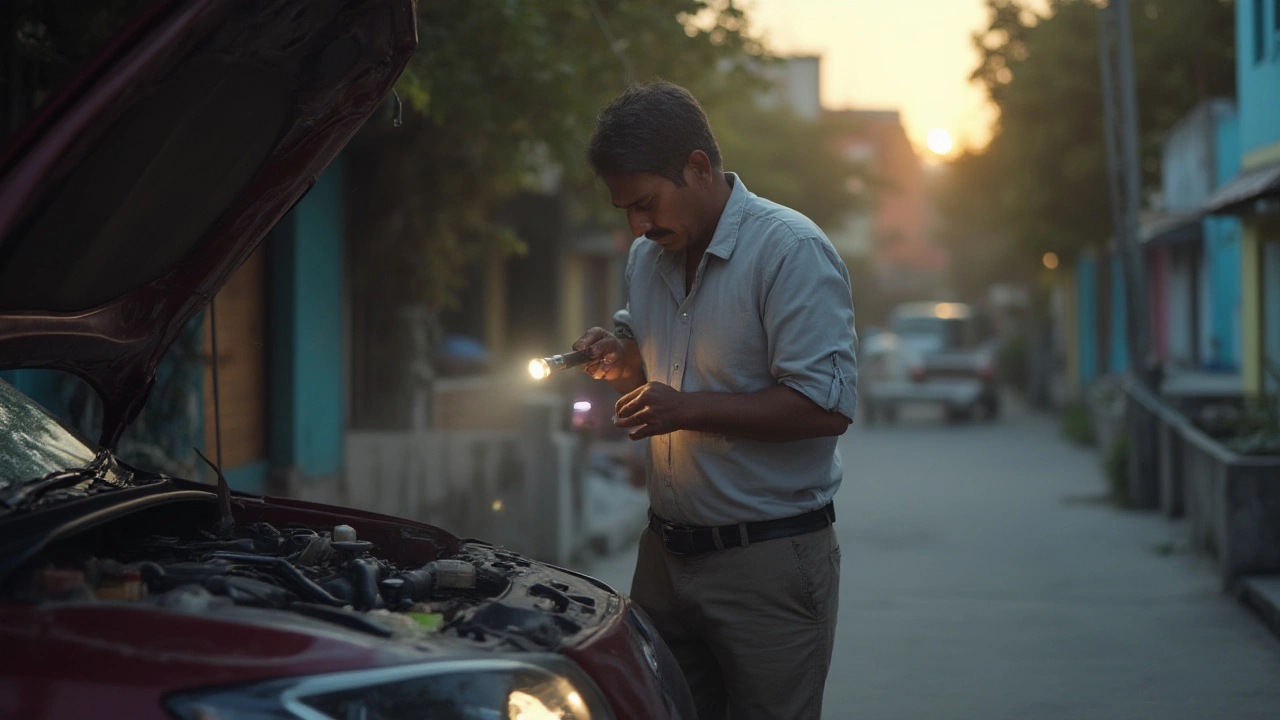Spotting Signs of a Failing Car Battery: Essential Checks Every Driver Should Know
 Jul, 28 2025
Jul, 28 2025
Ever had your car refuse to start just when you’re running late for something important? Most of us can relate. Dead batteries don’t care about your schedule, and they have a habit of giving up when it hurts most. But here’s a little secret: your car almost always tries to tell you the battery is going bad—if you know what signs to spot.
Classic Symptoms Your Car Battery is Saying Goodbye
Car batteries rarely just stop working out of the blue. Instead, they begin to falter in small but obvious ways. The most familiar sign is sluggish starting. When you turn your key or hit the start button, if your engine cranks slowly, groans, or takes longer than usual, the battery is losing strength. This is easily the top telltale sign. Add in the flickering cabin lights or dash panel, especially when the engine is off, and you’re staring at another red flag.
If you turn the key and hear a series of rapid clicks, or maybe nothing at all, that's often a sign of not enough juice. Accessories act wonky too. Power windows crawl up slower, seat warmers and radios seem less lively, and your headlights look dim or yellowish when you idle at night—a classic dying battery move. If the "Check Battery" or a battery light flickers on your dashboard, don't brush it off. That little icon’s not just for decoration. It’s there for a reason and often means the battery voltage has dropped below safe levels.
Don’t ignore weird smells coming from the hood, either. A battery near the end of its life sometimes leaks gas—hydrogen sulfide smells like rotten eggs. Not only is this unpleasant, but it’s also a clue the battery is leaking or venting gases, which isn’t safe. Pop the hood and look at the battery. If you spot corrosion (white, blue, or green powder) around the terminals, or if the case is bloated, cracked, or misshaped, it's time to shop for a replacement. Even a battery that’s four or five years old with no obvious problems might be sneaking towards the end. Age alone is a huge factor because most batteries in normal conditions last 3–5 years tops.
| Symptom | Possible Cause |
|---|---|
| Slow engine crank | Insufficient starting amps from battery |
| Dim headlights | Low battery voltage |
| Corrosion on terminals | Leaking/venting battery acid |
| Swollen battery case | Overheating or internal fault |
| Electrical accessories malfunction | Low stored energy |
| Check Battery light | Battery voltage below threshold |
One survey from AAA reported that battery-related issues are the number one cause for roadside assistance calls, accounting for over 23% of service requests each year. Batteries just don’t last as long as some folks think, and ignoring their hints will almost always end with a no-start situation—at the worst possible time.
Simple Ways to Test If Your Battery Is On Its Last Legs
You don’t need to be a mechanic to get a sense of your battery’s health. While a pro can run deep diagnostics, you can spot-check at home with some basic tricks. Start by turning everything electrical in your car off and seeing how confidently the engine starts in the morning. Early morning starts are hardest because the battery is cold and hasn’t benefited from recent charging. Weak cranking means the battery is struggling.
You can also try this: start your car at night, park close to a wall, and watch how your headlights behave. Then turn the car off with the headlights on. If the lights quickly dim or wink out as soon as the engine stops running, your battery voltage isn’t strong enough. The same test goes for power windows and radio—try running them with the engine off and notice sluggishness or power drops.
For anyone with a voltmeter or cheap multimeter at home, you can check the battery voltage across the terminals. A fully charged healthy 12-volt car battery will measure about 12.6 volts or just above when the car has been parked overnight. If it drops below 12.4 volts, it’s losing capacity. Under load (as soon as you start the engine), if the voltage falls below 10 volts, the battery’s about done. Most auto parts stores also check batteries for free using special testers that do a "load test." This tells you if the battery holds enough charge to start your car under real-world conditions.
If you’re feeling technical, you can check for “parasitic drain”—something in the car drawing power when the car’s off. But honestly, most dead batteries are just old. If you hear slow cranking, notice dim lights, and the battery is over three years old, consider that your warning sign. Here’s a pro tip: check the date code on your battery case or receipt sticker. Many batteries will have the month and year stamped or labeled. If you see something like "03/21" it means March 2021—and you can do the math about how old it’s getting.
Sometimes, cold weather is the culprit, even on good batteries. Sub-zero temps slow down chemical reactions inside the battery, taking its power from healthy to unreliable in a flash. Experts at Johnson Controls (a leader in battery manufacturing) once stated,
"Car batteries can lose up to 60 percent of their strength at 0°F, and 35 percent at freezing—meaning what worked fine last week might not cut it in a winter cold snap."So if you live in a place with harsh winters, extra caution is smart around battery age three.

Why Batteries Go Bad and How to Make Yours Last Longer
Most people think of car batteries as mysterious black boxes, but they’re just chemical storage tanks. Inside, lead plates and an acid solution create electricity through a pretty basic reaction. Over time, every start-chip, phone charge, or even left-on dome light chips away at the battery’s stored energy. Recharge cycles and everyday drain slowly wear down its capacity. Eventually, the lead plates corrode or the solution dries out, and it can’t hold enough charge to work reliably.
Driving habits are a big deal. A lot of short trips, say to the store or school and back, don’t give the alternator enough time to top up the battery. Deep discharge (draining the battery almost completely, like leaving the headlights on) seriously reduces a battery’s lifespan. Hot weather (think 90°F and up) is even worse for batteries than cold. Heat speeds up corrosion inside the battery cells, and an under-hood temp of 120–130°F is common after city driving. That explains why drivers in Phoenix or Miami replace batteries way more often.
Keeping terminals clean helps, since corrosion makes it harder for electricity to flow. Using a wire brush and a bit of baking soda solution scrubs off the gunk. If you don’t drive for a while, use a trickle charger or battery tender—especially on newer cars loaded with electronics that sip power even when "off." Most modern vehicles always draw a slight amount of current for alarm systems, clocks, and memory settings. This background drain adds up, especially if you let the car sit for weeks; it’s called a parasitic load.
Weather and bad luck aside, you can stretch your battery’s life with a few simple habits:
- Drive your car often. Aim for at least one decent 20-minute drive every week to allow proper charging.
- Double-check all lights are off before locking and walking away, especially interior dome and trunk lights.
- Keep the top of the battery clean and dry. Dirt can act as a conductor, slowly draining charge.
- If you park outside in extreme cold, a battery blanket can keep things warmer and reduce winter drain.
- Ask your mechanic to check battery terminals for tight, clean connections during oil changes.
Buying a "maintenance-free" battery saves on hassle, but don’t let the name fool you. Every battery needs a little attention once a year. Even premium batteries from trusted brands like Optima or Interstate follow the same basic lifespan rules. Interesting side note: electric cars use separate, smaller 12-volt batteries to power computers and lights; these fail in the same way, so EV owners aren’t off the hook either.
What To Do When Your Battery Finally Dies
If your battery fails, don’t panic. Most of us face this hassle, and it’s fixable. The first step is to confirm the battery is the problem, not the starter or alternator. If the interior lights still come on brightly, but you only get a single click from under the hood, you might have a bad starter. If you get a slow whirring and the lights fade as you try to crank, it's almost always the battery.
Jump-starting gets you going. Use a quality set of jumper cables or a portable jump pack, and get help from someone’s working car. Attach the red cable to the dead battery's positive terminal, connect the black to a solid piece of metal on the engine (not the battery itself), and let the running car charge yours for a few minutes. Always follow your car’s manual for specifics—some newer vehicles can have complex systems. Once you’re up and running, drive for 30–40 minutes to recharge the battery. If it dies again the next day, it's time to replace the battery because it can’t hold a charge. Modern batteries are sold at nearly every auto shop, warehouse store, and even big supermarkets, and most retailers install them for free when you buy on-site.
You should also get your charging system checked. A failing alternator won’t recharge the battery properly, meaning you could install a new battery only to face problems a week later. Many auto stores offer quick alternator tests at no charge. There’s little benefit to buying the most expensive battery on the shelf unless your car specifically needs extra cranking amps (for a big engine or subzero winters). Just pick a reputable brand and look for one with a fresh date code for maximum life.
A little story here: a friend of mine ignored his battery light for weeks thinking it was a sensor glitch. Then, without warning, his car died during rush hour on a six-lane city road. It was a pain to get towed and cost more than if he’d just swapped the battery at the first sign. It’s simple—if your car hints something is off, take it seriously. Fancy modern cars rely on battery health way more than we think. When in doubt, don’t hesitate to have a pro check things out before you’re stuck in the wrong place at the wrong time.
This is one of those things you don’t think about until it fails, but when it does, it’s a reminder that car batteries are the quiet heroes of our daily drives. Notice the warning signs, keep an eye on the age, and your ride will stay ready when you need it most.